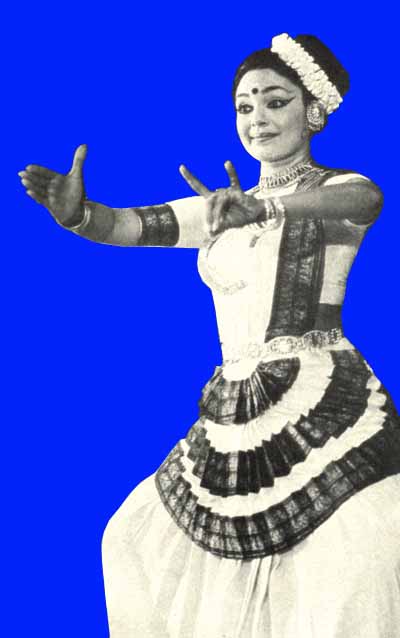Mohini Attam is the feminine dance form of Kerala, a state in the south western most part of India. It is danced by women and is known for its very sensual themes. Mohini Attam has an extremely, slow seductive quality. It has only been in recent decades that Mohini Attam has risen in popularity and acceptability

Costume
There is a typical costume for Mohini Attam. It is generally simple and white, or off-white. Usually there is a gold brocade, possibly with a border of red. One of the most characteristic signs of the Mohini Attam dancer is the bun of hair worn off-centre. This is very much a characteristic of women from Kerala.

The Myth
The myth of Mohini is central to the performance. According to the story, Brahma tells the other Gods how they can obtain amrit (celestial ambrosia); amrit bestows immortality and great power. He informs them that they can do so by churned up the ocean of milk. Unfortunately, the job is so great that the gods are forced to seek the assistance of the demons. The demons agree to help, but are secretly plotting to keep it all for themselves.
So the fateful day finally comes. The amrit has been rendered, but only after many difficulties. Vishnu finds out about the plot to steal the amrit. He knows that it would be disastrous for the demons to obtain such powers.
Vishnu decides to thwart the demons in their plans to steal the amrit. He takes the form of a beautiful celestial nymph (apsara), and by way of her amorous charms distracts them from their plans. By means of this distraction the amrit is given to the gods, and the world is saved from the demons.
General Considerations
Mohini Attam is just beginning to be accepted outside of Kerala. One is starting to find it used at toward the end of Bharat Natyam perfomances. Therefore, one is starting to find instruments that are normally associated with Bharat Natyam (e.g., mridangam, vina, venu). However more traditional forms use instruments such as shuddha madalam and edakka (uddaku).
Although there is a general tendency to call Mohini Attam classical, this is probably not justifiable. It is more appropriate to call Mohini Attam a traditional dance form.; We have three benchmarks to, help us decide whether something is classical; age, the ability to cross ethnic boundaries, and upper class associations. Mohini Attam clearly fails two of these benchmarks. It is very old, so this is not an issue. However, it has a very limited acceptance in the non-Malayali (non Keralite) communities. Furthermore, until recently it was generally looked down upon in “polite” society, so it was not something that had upper class connotations.
Selected Video
Other Sites of Interest
On Filming Classical Indian Dance
The Limits Of Orientalism: Classical Indian Dance And The Discourse Of Heritage
From interculturalism to historicism: reflections on classical Indian dance (2000/1)
Classical Indian Dance in Literature and the Arts Kapila Vatsyayan (Book Review)
From: Bodies that Matter: on the Discursive Limits of ‘sex'
The Theory and Technique of Classical Indian Dancing
From Interculturalism to Historicism: Reflections on Classical Indian Dance
Classical Indian Dance and Women’s Status
Bharata Natyam: A Classical Indian Dance in Transition
